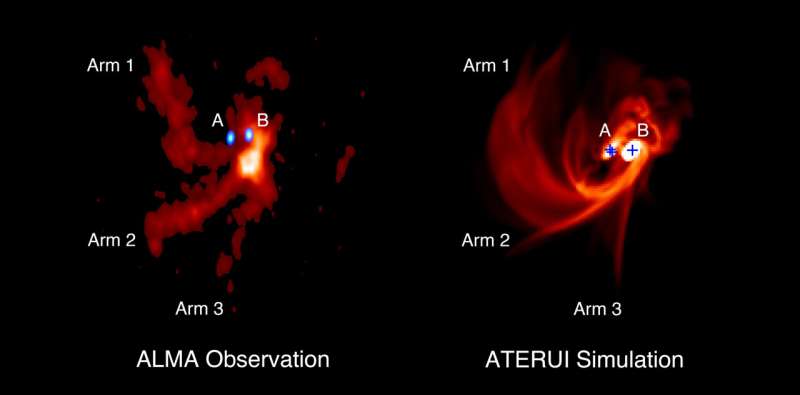This article has been reviewed according to Science X's editorial process and policies. Editors have highlighted the following attributes while ensuring the content's credibility:
fact-checked
peer-reviewed publication
trusted source
proofread
Team identifies gas streamers feeding triple baby stars

New observations and simulations of three spiral arms of gas feeding material to three protostars forming in a trinary system have clarified the formation of multi-star systems.
Most stars with a mass similar to the sun form in multi-star systems together with other stars. So an understanding of multi-star system formation is important to an overall theory of star formation. However, the complexity and lack of high-resolution, high-sensitivity data has left astronomers uncertain about the formation scenario.
In particular, recent observations of protostars often reported structures called "streamers" of gas flows toward the protostars, but it has been unclear how these streamers form.
An international team led by Jeong-Eun Lee, a professor at Seoul National University, used the Atacama Large Millimeter/submillimeter Array (ALMA) to observe the trinary protostar system IRAS 04239+2436 located 460 light-years away in the constellation Taurus. The team found that emissions from sulfur monoxide (SO) molecules trace three spiral arms around the three protostars forming in the system. Their paper is published in The Astrophysical Journal.
Comparison with simulations led by Tomoaki Matsumoto, a professor at Hosei University using the supercomputers ATERUI and ATERUI II in the Center for Computational Astrophysics at the National Astronomical Observatory of Japan (NAOJ) indicate that the three spiral arms are streamers feeding material to the three protostars.
The combination of observations and simulations revealed, for the first time, how the streamers are created and contribute to the growth of the protostars at the center.
More information: Jeong-Eun Lee et al, Triple Spiral Arms of a Triple Protostar System Imaged in Molecular Lines, The Astrophysical Journal (2023). DOI: 10.3847/1538-4357/acdd5b
Journal information: Astrophysical Journal
Provided by National Astronomical Observatory of Japan





















